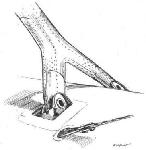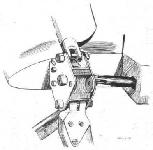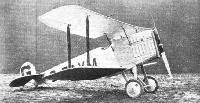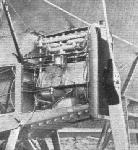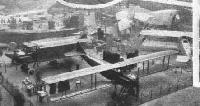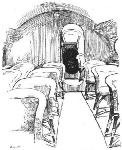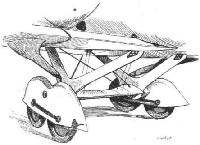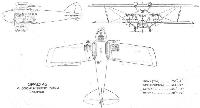Фотографии
-
The Breguet "Sesquiplan," type "19 A.2," is a "Grande Reconnaissance" two-seater fighter, constructed of metal throughout except for the wing covering.
Самолёты на фотографии: Breguet Br.19 - Франция - 1922
-
Tail skid, rudder-crank, etc., of the Breguet "Sesquiplan."
Самолёты на фотографии: Breguet Br.19 - Франция - 1922
-
The interplane struts of the Breguet "Sesquiplan," are forked at the ends to meet the two wing spars.
Самолёты на фотографии: Breguet Br.19 - Франция - 1922
-
THE PARIS SALON: Farman Goliath.
Самолёты на фотографии: Farman F.62BN.4 / F.160 Goliath - Франция - 1922
-
The De Havilland "32" commercial biplane, 360 h.p. Rolls-Royce.
Самолёты на фотографии: De Havilland D.H.32 / D.H.34 - Великобритания - 1921
-
THE HANDLEY PAGE W8. - Our photograph shows this machine, which has two Napier "Lion" engines, starting off for its first flight to Paris, which was made in two hours five minutes.
Самолёты на фотографии: Handley Page H.P.18 (W.8) / H.P.30 (W.10) - Великобритания - 1919
-
Регистрационный номер: F-ADBL The Vickers "Viking" Mk.IV Amphibian flying boat (Napier "Lion").
Самолёты на фотографии: Vickers Viking / Type 54 - Великобритания - 1919
-
Регистрационный номер: J6855 The Vickers "Vimy" transport (two Napier "Lions").
Самолёты на фотографии: Vickers Vimy Commercial - Великобритания - 1919
-
Регистрационный номер: F-ADER THE VICKERS-VIMY-COMMERCIAL, TWO NAPIER "LION" ENGINES: The identification letters on this machine are "F-ADER."
Самолёты на фотографии: Vickers Vimy Commercial - Великобритания - 1919
-
View inside the Vickers-Vimy-Commercial exhibited on the stand of Ateliers des Mureaux. The machine, which has been purchased for use by the Grands Express Aeriens, is richly finished in leather repousse work
Самолёты на фотографии: Vickers Vimy Commercial - Великобритания - 1919
-
Header tank, mounted on the strut.
Самолёты на фотографии: Vickers Vimy Commercial - Великобритания - 1919
-
One of the Supermarine "Channel" type machines (160 h.p. Beardmore engines) flying.
Самолёты на фотографии: A.D. Flying Boat - Великобритания - 1916
-
THE PARNALL "PUFFIN": Front view of the machine with wings folded. The large angle of the planes when folded is due to the pronounced stagger. Note the amphibian gear working in a slot in the main float.
Самолёты на фотографии: Parnall Puffin - Великобритания - 1920
-
THE PARNALL "PUFFIN": Front view.
Самолёты на фотографии: Parnall Puffin - Великобритания - 1920
-
The Ansaldo Passenger Machine.
Самолёты на фотографии: Ansaldo A-300 - Италия - 1919
-
The wing spar attachment on the end of the wing roots of the Ansaldo "A.300T."
Самолёты на фотографии: Ansaldo A-300 - Италия - 1919
-
Side view of the Ansaldo "A.300T."
Самолёты на фотографии: Ansaldo A-300 - Италия - 1919
-
THE HANDLEY PAGE SLOTTED WING TESTED AS A MONOPLANE: 1. The complete machine. 2. Slot closed and aileron normal. 3. Slot open and aileron normal. 4. Slot open and aileron down.
The photographs show a Handley Page slotted wing mounted on the fuselage of a D.H.9A. The machine is comparatively crudely made, but it has served to demonstrate that the scale effect is normal for a slotted wing, and also that the slotted ailerons fitted are effective up to the angle of maximum lift. A more refined machine is now being built, and the full-scale experiments will then be continued with the latest forms of slots.Самолёты на фотографии: Handley Page H.P.17 / H.P.20 - Великобритания - 1920
-
Регистрационный номер: G-EAYM The Avro "Baby," fitted with a 35 h.p. Green engine.
Самолёты на фотографии: Avro Baby / Type 534 - Великобритания - 1919
-
The 35-40 h,p. Green engine, installed in an Avro "Baby" biplane.
Самолёты на фотографии: Avro Baby / Type 534 - Великобритания - 1919
-
The Blackburn "Swift" torpedo 'plane, fitted with a 450 h.p. Napier "Lion."
Самолёты на фотографии: Blackburn Swift T.1 / Dart T.2 - Великобритания - 1920
-
Регистрационный номер: G-EAWY The Bristol 10-seater commercial biplane, fitted with a Napier "Lion."
Самолёты на фотографии: Bristol Ten-Seater / Brandon - Великобритания - 1921
-
The Cabin of the "Bristol" Ten-Seater: Although not including all the seats, this photograph gives an excellent idea of the roominess of the cabin and of the good view obtained through its windows. The machine, which has a 450 h.p. Napier "Lion" engine, was fully described in our issue of July 7, 1921.
Самолёты на фотографии: Bristol Ten-Seater / Brandon - Великобритания - 1921
-
Регистрационный номер: N134 A FAIREY AMPHIBIAN: The photograph of the machine just after alighting shows the trailing edge of the wings pulled down to give greater lift. This hinged trailing edge is a feature of all Fairey seaplanes.
Самолёты на фотографии: Fairey Pintail / Fawn - Великобритания - 1920
-
Регистрационный номер: N135 TWO VIEWS OF THE FAIREY "PINTAIL": This machine is an amphibian with Napier "Lion" engine.
Самолёты на фотографии: Fairey Pintail / Fawn - Великобритания - 1920
-
THE PARIS SALON: F.B.A. (flying boat hulls).
Самолёты на фотографии: FBA Type 16 / 17 - Франция - 1923
-
Регистрационный номер: G-EAPC Central Aircraft machine. The "Centaur" 2A, 320 h.p. (two 160 h.p. Beardmores), eight-seater commercial biplane.
Самолёты на фотографии: Central Centaur IIA - Великобритания - 1919
-
Регистрационный номер: G-EAXZ The British Deutsch Cup Challenger: The Mars I, designed by Mr. H. P. Folland and built by the Gloucestershire Aircraft Co. of Cheltenham, was fitted while at Etampes with Lamblin radiators. The result was an increase in speed of several miles per hour, and but for the fabric stitching failing, this machine would undoubtedly have given an excellent account of itself in the race. Incidentally, what about adapting this type of machine for military purposes? With slightly larger wings, so as to improve the climb and reduce the landing speed, it should prove a formidable rival to existing types.
Самолёты на фотографии: Gloster Mars (Bamel) / Nighthawk / Sparrowhawk - Великобритания - 1921
-
Four types of the Gloucestershire Aircraft Co.'s products. Reading from left to right: Top, the "Mars I" (450 Napier "Lion") racer and the "Mars II" (230 B.R.2) fighting scout; bottom, the "Mars III" (230 B.R.2) training machine and the "Mars IV" (230 B.R.2) fighting scout, ship's 'plane.
Самолёты на фотографии: Gloster Mars (Bamel) / Nighthawk / Sparrowhawk - Великобритания - 1921
-
THE PARIS SALON: Pierre Levasseur.
Самолёты на фотографии: Levasseur PL.2 - Франция - 1922
-
The Supermarine "Seal" Amphibian flying boat (450 h.p. Napier "Lion").
Самолёты на фотографии: Supermarine Seal / Seagull - Великобритания - 1921
-
The Supermarine "Seal": Front view of the hull and centre-section, showing amphibian gear.
Самолёты на фотографии: Supermarine Seal / Seagull - Великобритания - 1921
-
Регистрационный номер: N146 The Supermarine "Seal": View of the machine taxying. Note the wheel well clear of the water.
Самолёты на фотографии: Supermarine Seal / Seagull - Великобритания - 1921
-
The Supermarine "Seal": The machine coming on to the slipway. The wheels have not yet been lowered.
Самолёты на фотографии: Supermarine Seal / Seagull - Великобритания - 1921
-
Supermarine "Seal" Mk II Napier "Lion" Engine
Самолёты на фотографии: Supermarine Seal / Seagull - Великобритания - 1921
-
THE WESTLAND "WALRUS" FLEET SPOTTER, with Napier "Lion" engine: Three-quarter front view. The photograph shows the machine fitted with the "Grain" type of flotation gear.
Самолёты на фотографии: Westland Walrus - Великобритания - 1921
-
Регистрационный номер: N9500 THE WESTLAND "WALRUS" FLEET SPOTTER: Three-quarter rear view. The projection under the fuselage is a chamber in which the observer can lie down so as to get an uninterrupted view of a wide area of the sea.
Самолёты на фотографии: Westland Walrus - Великобритания - 1921
-
Side view of the Breguet "14T bis."
Самолёты на фотографии: Breguet Br.18 Berline / Br.14T - Франция - 1919
-
Регистрационный номер: F-ADAK THE PARIS SALON: Nieuport Astra.
Самолёты на фотографии: Nieuport Nieuport-30 - Франция - 1919
-
THE PARIS SALON:The small Ricci Triplanes.
Самолёты на фотографии: Ricci R.6 - Италия - 1920
-
Регистрационный номер: G-EAOQ Central Aircraft machine. The "Centaur" 4 school biplane (100 h.p. Anzani)
Самолёты на фотографии: Central Centaur IV - Великобритания - 1919
-
MARTINSYDES FOR SPAIN: One of Martinsyde F.4a (300 h.p. Hispano) two-seater biplanes recently supplied to the Spanish Government. A representative of the Spanish Government was at Brooklands, and made a trip in each of the machines before taking delivery.
Самолёты на фотографии: Martinsyde F.4A / F.6 / A - Великобритания - 1919
-
Front portion of the fuselage of the all-metal Breguet "Leviathan."
Самолёты на фотографии: Breguet Br.20 / Br.22 Leviathan - Франция - 1922
-
THE PARIS SALON: Breguet Leviathan.
Самолёты на фотографии: Breguet Br.20 / Br.22 Leviathan - Франция - 1922
-
THE PARIS SALON: Rene Tampier.
Самолёты на фотографии: Tampier T.1 - T.4 - Франция - 1921
-
THE PARIS SALON: One of two large three-engined machines, the Potez.
Самолёты на фотографии: Potez Potez X / XVIII / XXII - Франция - 1921
-
The Marcel Besson single-seater flying-boat type "H.6."
Самолёты на фотографии: Besson H-6 - Франция - 1921
-
The tail plane of the Marcel Besson flying boat is supported on a single ''leg-o'-mutton" strut. The sketch shows the adjustment.
Самолёты на фотографии: Besson H-6 - Франция - 1921
-
Sketch of the engine struts and cockpit of the Marcel Besson flying boat.
Самолёты на фотографии: Besson H-6 - Франция - 1921
-
THE SPAD 45: Fitted with four 300 h.p. Hispano engines, this machine carries a crew of three and seventeen passengers.
Самолёты на фотографии: Bleriot-SPAD S.45 - Франция - 1921
-
View inside the cabin of the Spad 45.
Самолёты на фотографии: Bleriot-SPAD S.45 - Франция - 1921
-
The undercarriage of the Bleriot four-engined machine.
Самолёты на фотографии: Bleriot-SPAD S.45 - Франция - 1921
-
An aileron crank inside the wing of the four-engined Spad 45.
Самолёты на фотографии: Bleriot-SPAD S.45 - Франция - 1921
-
SPAD 45 4 300 HP Hispano-Suiza Engines
Самолёты на фотографии: Bleriot-SPAD S.45 - Франция - 1921
-
THE SPAD 34 : This machine is a side-by-side, dual control school machine, with 80 h.p. Le Rhone engine.
Самолёты на фотографии: Bleriot-SPAD S.34 - Франция - 1920
-
THE PARIS SALON: S.E.C.M.
Самолёты на фотографии: SECM (Amiot) SECM 10 / 12 BN2 - Франция - 1921
Статьи
- Flight


